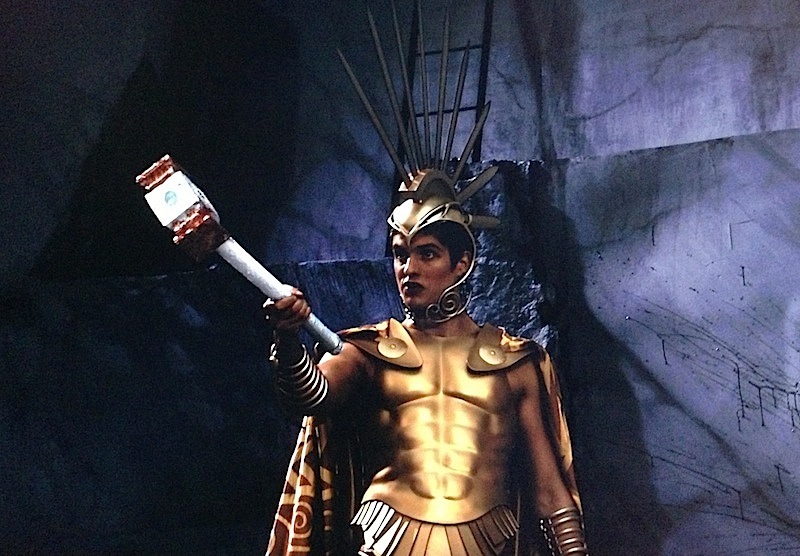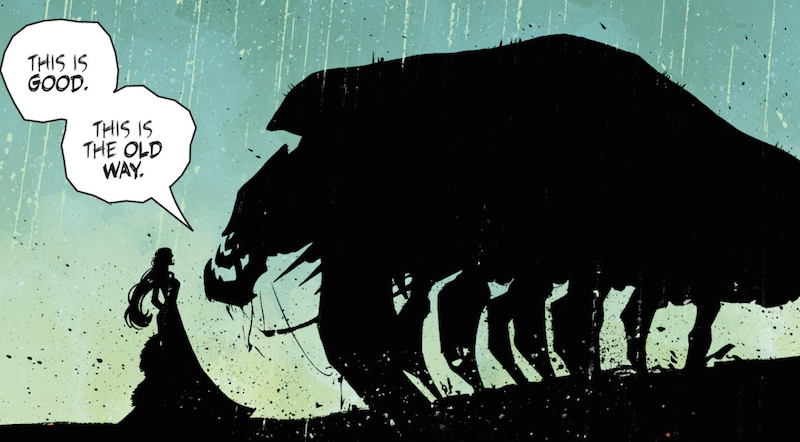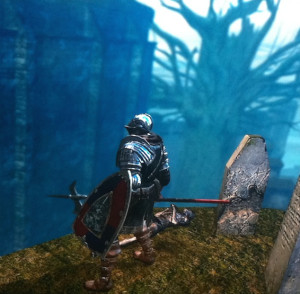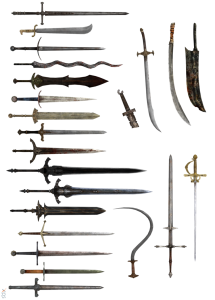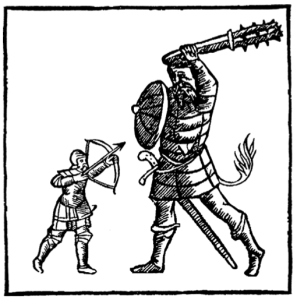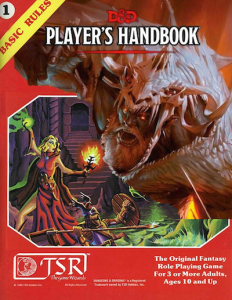The Hazard System is the gameplay engine behind The Final Castle. Though it assumes games of fantasy adventure and exploration, it is modular and should be easily adaptable to many kinds of tabletop RPGs. I use some variation on this approach for pretty much every game I run now and I don’t think I could go back to any other method of pacing or timekeeping. It is the natural outgrowth and generalization of the overloaded encounter die.
Gameplay proceeds in turns at different fictional timescales with each turn accompanied by the chance of a hazard. What “hazard” means will vary based on the context. For example, a hazard during a haven turn, when characters are recovering between adventures, might be a natural disaster, while a hazard during a dungeon turn, a much shorter period of fictional time, might be an encounter with a wandering monster. The hazard system also serves as a general timekeeping and resource tracker.
The text below the divider is released under a Creative Commons Attribution 3.0 Unported license. Attribution:
Necropraxis Productions Hazard System v0.2 http://www.necropraxis.com/hazard-system/
A PDF is also available.
Currently, several references to undefined terminology from The Final Castle remain, such as Ability Tests. It should be relatively easy to interpret these in light of whatever system you are using, but the final Hazard System text will likely be entirely system agnostic. Additional turn types will also likely be included (Domain Turns and Generation Turns, particularly).
Hazard System v0.2
The game proceeds in turns of several different types. The turn types are haven, wilderness, dungeon, and combat. Each represent a progressively smaller amount of fictional time within the game world, though the exact durations are usually abstract. The passage of time within each turn is a resource to be spent wisely, as the hazard die is rolled for every turn that passes to represent potential danger.
The Hazard Die
The six-sided Hazard Die deploys threats, manages resources, keeps time, and tracks light. In short, it is the engine that drives gameplay forward and the heart of the Hazard System. Every significant action, whether in town recovering, traveling through the wilderness, or searching a dungeon corridor for traps, takes a turn. Every turn is accompanied by a roll of the Hazard Die. The exact interpretation of the die result varies by turn type, but the outcomes are conceptually similar. A haven hazard might be a shortage of supplies while a dungeon hazard might be a wandering monster.
Players other than the referee should roll the Hazard Die to make the time cost salient. After rolling the Hazard Die, hand it to another player so that everyone gets a chance. If playing in person, rotating clockwise around the table works well.
Beginning the game
Start a new campaign with the first Wilderness or Dungeon turn of an adventure. Players should choose a clue or quest from the Tavern to pursue. Roll HP following Recovery guidelines to determine initial HP.
Starting and ending sessions
Sessions should begin and end in a Haven if possible. This allows the the players and PCs to vary between sessions. After a session, players should tell the referee if they are going to follow a different clue or Quest during the next session so that the referee can do any preparation required beforehand.
Haven turns
To recover and replenish resources in a civilized refuge, take a Haven Turn. The exact fictional duration of a Haven Turn can be anything from a few days to several weeks. It is rarely necessary to interrogate the details.
- Roll the Hazard Die and resolve any hazard
- Pay upkeep: accommodation, retainer, property, and so forth
- Recover (roll HP, applying accommodation modifiers)
- Process retainer loyalty
- Reckon XP gained and level up if appropriate
- Buy or sell items, repair damaged gear, or recruit hirelings
- Optionally, take one Haven Action (scribe scroll and so forth)
- Prepare spells
- Review rumors and news
Haven Hazard Die results
- Complication (introduce at any point during the turn)
- Clue about next complication
- Abatement of one or more (by referee whim) haven conditions
Ignore results of 4 – 6. Starred complications persist as conditions.
Haven complications
| 1. |
Assassination |
11. |
Insurrection * |
| 2. |
PC challenged |
12. |
Invasion * |
| 3. |
Curse * |
13. |
Jailbreak |
| 4. |
Earthquake |
14. |
Mobilization * |
| 5. |
Flood |
15. |
Monster attack |
| 6. |
Falling star |
16. |
Murderer on the loose * |
| 7. |
Famine * |
17. |
Pestilence * |
| 8. |
Fire |
18. |
PC slandered |
| 9. |
PC impersonated |
19. |
PC item stolen |
| 10. |
Inflation * |
20. |
Winter * |
Wilderness turns
Wilderness turns alternate between day and night. Characters taking two non-camp wilderness actions in a row suffer 1 damage and gain a point of Exhaustion. Choose a wilderness action: travel, search, explore, hunt, track, or camp.
Travel
Move the party into an adjacent area or access a known landmark such as a haven or dungeon.
Search, Explore, Hunt, or Track
The party leader makes a Search Test to locate (and enter, if desired) a hidden feature. To Explore, Search without a stated goal. Success reveals a random hidden feature. Track is a Search to follow a quarry. Hunting yields 1d6 rations (adjust for terrain) per hunter. Night applies a -1 penalty to Search, Hunt, or Track.
Camp
Camping requires a bedroll and consuming 1 ration per character. One person may stand watch for each four party members without impairment. Ignore Hazard Die results above 3.
Wilderness Hazard Die results
- Encounter (may differ between day and night)
- Percept (regarding next encounter)
- Locality (mechanical change in environment)
- Percept (regarding hidden feature)
- Resource exhaustion
- Lost
Lost
Travel is no longer an option if a party is lost. Search must be used to locate a landmark before travel can be resumed.
Exhaustion
Each point of Exhaustion imposes a cumulative -1 penalty on all physical Ability Tests. This adds to Encumbrance penalties.
Dungeon turns
Some actions that require a Dungeon Turn include climbing, forcing a door, guarding the party, listening at a door, moving to a new area, searching the current area, and other tasks of similar scope. Each player may take a different action during a Dungeon Turn. Dungeon Turns can represent a fictional amount of time anywhere between a few minutes to an hour, though most commonly are about 10 minutes long.
In practice, the passage of Dungeon Turns can be more fluid than selecting actions by name, resolving any hazard, and iterating. However, always remain cognizant of lurking dangers and call for the Hazard Die whenever significant actions are taken.
Free dungeon actions
Minor actions often do not consume a full Dungeon Turn. Interacting with particular features such as looking under a rug, opening doors that are not stuck, and pulling levers are all free actions. Clever use of free dungeon actions can forestall the Hazard Die and thus decrease risk.
Dungeon Hazard Die results
- Encounter
- Percept (regarding next encounter)
- Locality (mechanical change in environment)
- Fatigue (take 1 damage unless the next turn is spent resting)
- Resource exhaustion (spell duration, etc)
- Light source exhaustion (any or all light sources go out)
Reasonable resolution
Fatigue and light source results may be ignored when they do not make fictional sense, such as during the first few turns of an exploration. Exhausted light sources rarely all go out at exactly the same time, but instead dwindle over the course of the turn, and may be relit given sufficient PC resources.
Released under the Creative Commons Attribution 3.0 Unported license
Attribution:
Necropraxis Productions Hazard System v0.2 http://www.necropraxis.com/hazard-system/

